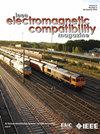Machine Learning to Predict EMI Radiation and Optimize the Structure of Pinmap Packages
IF 2.5
3区 计算机科学
Q3 ENGINEERING, ELECTRICAL & ELECTRONIC
IEEE Transactions on Electromagnetic Compatibility
Pub Date : 2025-06-13
DOI:10.1109/TEMC.2025.3574362
引用次数: 0
Abstract
With the rapid increase in integrated circuit chip frequencies, the complexity of electromagnetic interference issues and the time-consuming nature of traditional pin mapping (pinmap) design methods have become increasingly evident. This article leverages advanced machine learning techniques to accurately and efficiently predict the maximum 3-m radiated electric field of pinmap packages. Among the various models tested, the convolutional neural network (CNN) demonstrated the best performance. When combined with the Adam optimizer, the CNN achieved an average relative error of less than 1.5% across the 6 to 20 GHz frequency range. The trained CNN model’s prediction speed is several orders of magnitude faster than full-wave simulation methods. Furthermore, this article proposes a structural optimization method to minimize radiation in pinmap packages. By integrating ground ball position optimization with the trained CNN model, the method achieves optimal radiation suppression. Validation across three different cases demonstrated a reduction in radiation by 4.85 to 10.37 dB (mV/m), confirming the effectiveness and applicability of the proposed approach.机器学习预测电磁干扰辐射和优化pmap封装结构
随着集成电路芯片频率的快速增加,电磁干扰问题的复杂性和传统引脚映射(pinmap)设计方法的耗时性日益明显。本文利用先进的机器学习技术准确有效地预测了针状图封装的最大3米辐射电场。在测试的各种模型中,卷积神经网络(CNN)表现出最好的性能。当与Adam优化器结合使用时,CNN在6至20 GHz频率范围内的平均相对误差小于1.5%。训练后的CNN模型的预测速度比全波模拟方法快几个数量级。此外,本文还提出了一种结构优化的方法,以减少精确图封装中的辐射。该方法通过将滚地球位置优化与训练好的CNN模型相结合,实现了最优的辐射抑制。在三种不同情况下的验证表明,辐射减少了4.85至10.37 dB (mV/m),证实了所提出方法的有效性和适用性。
本文章由计算机程序翻译,如有差异,请以英文原文为准。
求助全文
约1分钟内获得全文
求助全文
来源期刊
CiteScore
4.80
自引率
19.00%
发文量
235
审稿时长
2.3 months
期刊介绍:
IEEE Transactions on Electromagnetic Compatibility publishes original and significant contributions related to all disciplines of electromagnetic compatibility (EMC) and relevant methods to predict, assess and prevent electromagnetic interference (EMI) and increase device/product immunity. The scope of the publication includes, but is not limited to Electromagnetic Environments; Interference Control; EMC and EMI Modeling; High Power Electromagnetics; EMC Standards, Methods of EMC Measurements; Computational Electromagnetics and Signal and Power Integrity, as applied or directly related to Electromagnetic Compatibility problems; Transmission Lines; Electrostatic Discharge and Lightning Effects; EMC in Wireless and Optical Technologies; EMC in Printed Circuit Board and System Design.

 求助内容:
求助内容: 应助结果提醒方式:
应助结果提醒方式:


